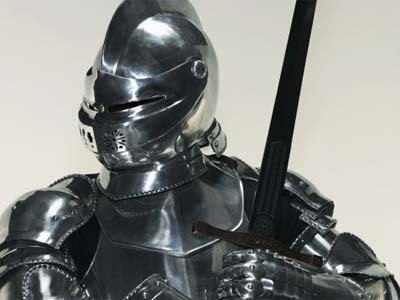We have a talented group of students in our FDC intensive course who performed their fight scenes on Friday as a test of their skills. Each scene is a performance, with dialogue memorized from a published script and full-speed choreography. Like a live professional show, there is no stopping midway and asking to start again.
We choreograph all the movement slowly at first. Then, as the actors gain more confidence with where and when to move and precision with their targets and timing, we can gradually increase the speed. But what else goes into a fully produced fight scene? If we want our performance to be as shiny as possible, what’s the best polish?
Acting Aggression
Siobhan Richardson is a Certified Fight Director and writes a blog called Burning Mountain. She wrote a short article that I highly recommend you read in full because every bit of advice is excellent.
Here’s a short excerpt from Acting Aggression:
Whenever you feel the energy drop, re-invest emotionally. You can absolutely have pauses in your movement, but always your character must be present, must be aware that they are in danger, must be at peak alterness. Whenever you pause, you are intensely watching your “adversary” to see what they’ll do next, like a cat watching for where the laser pointer will move to next.
This, more than anything else, is what it means to “act the fight”.
Learning to repeat choreography exactly the same way every time can drain the life from your character. For the same reason, some actors prefer improv to Shakespeare: learning complicated lines that must rhyme is harder than making up your own (for some).
When performing memorized lines, it’s critically important not to betray to the audience that you’re reciting the script. The acting part is to seem surprised about what the other character is saying, and to seem to discover your plan.
Even more than your memorized lines, choreography must seem spontaneous. Every attack is toward a target that you discover as an opportunity in that moment. Every parry or evasion happens just in time because you didn’t know they’d attack in that particular way until you saw their prep.
As Siobhan says, it’s not wrong to have pauses and breaks in the furious action. In fact, phrase breaks are the precious moments you can use to reveal your character's traits and changes.
Size and Shape
Keeping in mind that we always fully extend the arm on attacks to safely and accurately point at all targets, some characters are big and some are small. This has nothing to do with the actor’s height or flexibility. Nor does it relate to the character’s ability to fight. It is about urgency.
A master does not move with urgency because they are supremely confident. Pai Mei in Kill Bill or Neo at the end of the Matrix are examples of masters. They stay very still, but their hands and weapons are precise and confident.
An aggressive character moves with urgency because they are fuelled by rage. This makes them rush forward and commit their body. They cover a lot of distance as they charge and try to overpower their opponent.
A fearful character moves with urgency because they are trying to flee. They try to run away at every opportunity.
A pessimistic character does not move with urgency because they don’t know what to do. They try to become a small target and cover up so they don’t dare make big movements that expose their vulnerable parts.
The Change
Once you decide the general tenor of your character by thinking about size or urgency, decide on one moment in the fight when you switch to the opposite.
- An injury may cause you to lose confidence.
- Injuring the opponent may cause you to gain confidence.
- Taking a hit to the head may lead to dizziness and confusion.
Lines may also change your attitude toward the fight. You may lose the desire to fight when the opponent reveals a surprising truth. They may goad you or insult you, changing your reluctance into fury.
Choose one moment to make one major change, and your partner will chose their own moment, leading to two changes within the fight and a truly dramatic conflict.
Next Intensive Course
If you missed the FDC course this time, we’re running it next in January. It will have the same number of hours, but spread over three weeks and run from Sunday to Friday, from 1pm to 5pm, January 10 to 29. Mark your calendar!
